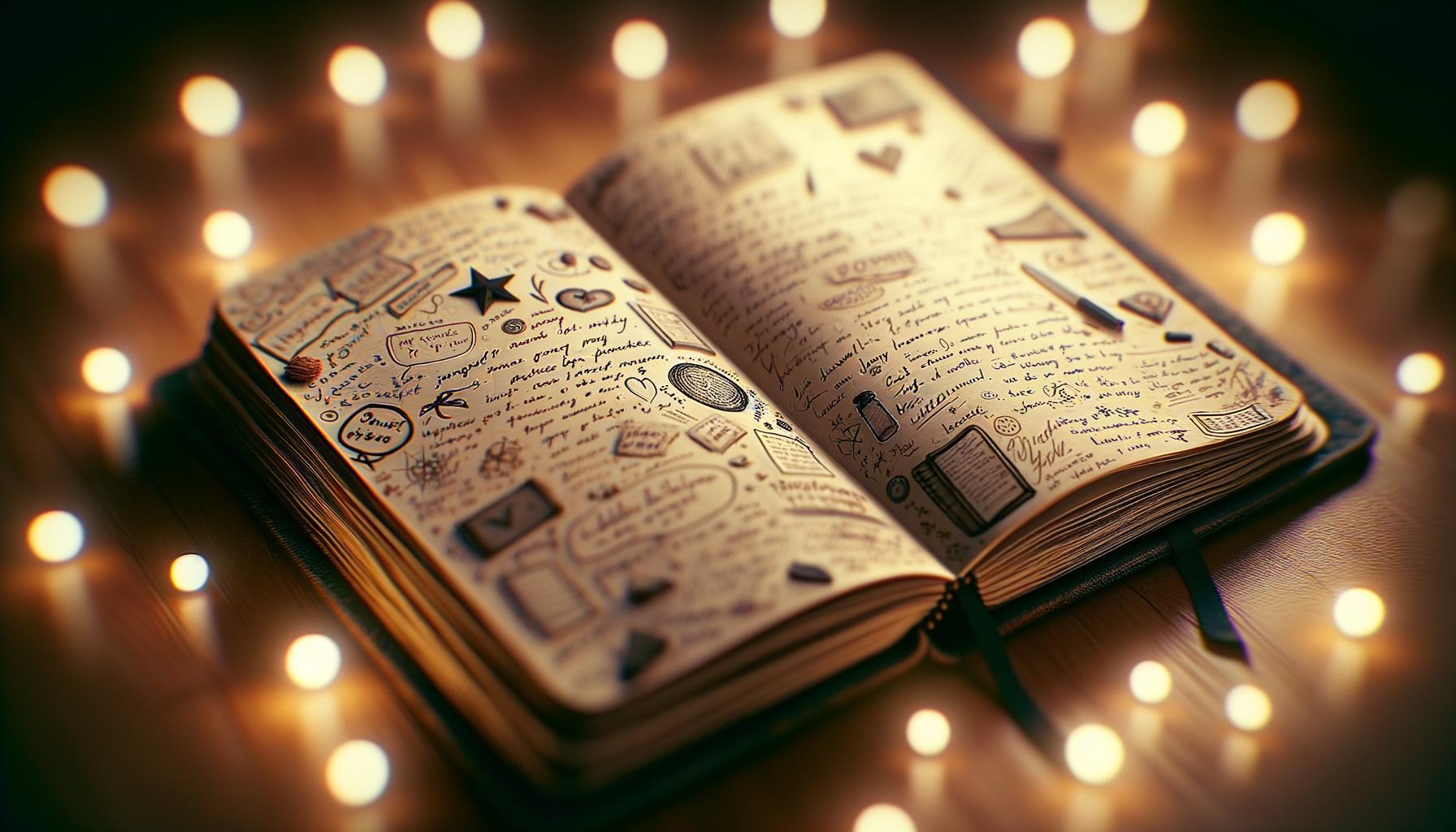Overcome Writer's Block: Smart Tips for a Steady Flow of Ideas

Imagine yourself sat at your desk, fingers poised over your keyboard but the words just won't flow. Welcome to the world of writer's block: an affliction that can hinder productivity and stifle creativity, bringing even the most talented wordsmiths to a frustrating standstill. Whether you're a seasoned novelist, a budding blogger, or a committed content creator, these impasses can strike at any time, often when you least expect it. In this article, we'll be delving deeply into the various causes of this pesky phenomenon, dissecting the psychological and physical factors that may be holding back your creativity. From stress and fear to perfectionism and a lack of inspiration, we'll identify potential problems and offers practical tips for overcoming writer's block. Understanding the blockade is the first step, then we'll journey through pre-writing strategies, mindful techniques, creative exercises, workspace setup, and much more. Keep reading to discover a realm filled with effective solutions designed to rekindle your love of writing and unlock a steady flow of ideas.
Understanding the Causes of Writer's Block

Comprehending the underlying reasons behind writer's block is paramount to overcoming it. The blockage of creativity is often tied to psychological factors such as stress, fear, and perfectionism. Anxiety causes turmoil in the mind, effectively obstructing our thought process and making it difficult for new ideas to sprout. Moreover, crippling fear of producing subpar work or being judged can also stifle creativity. For instance, even esteemed authors like Maya Angelou admitted to suffering from an imposter syndrome, showcasing fear's ability to hamstring even the most secure writers.
Apart from psychological elements, physical factors like exhaustion and lack of inspiration can also induce writer's block. A state of physical lethargy can leave little energy for the creative process. For instance, renowned science-fiction writer Philip K. Dick struggled with insomnia, which negatively impacted his prolific writing career. Further, inspiration, a bedrock for creativity, can be scarce at times. Historical novel author Hilary Mantel's account of her battle with writer's block highlights the importance of constant inspiration, and how its absence can lead to creative stagnation. So, understanding these causes of writer's block – both psychological and physical – is the first step towards devising a plan to overcome it.
Pre-Writing Strategies: Planning Ahead

Effective planning plays a crucial role in preventing writer's block. Putting your ideas into a detailed outline in a pre-writing phase gives structure to your thoughts and a roadmap for your writing journey. For example, acclaimed author J.K. Rowling went by meticulous planning, which involved detailed outlines, lists of characters, and key plot points before delving into the actual process of writing her world-renowned Harry Potter series. This strategy helps keep the creative stream organized and ongoing, thus reducing the likelihood of encountering writer's block.
Incorporating an outline in the planning stage is as essential for writers as a blueprint for architects. Whether you're penning a novel, a blog post, or an academic essay, crafting an outline can provide a clear direction that keeps you focused. Renowned novelist and short story writer Nathaniel Hawthorne was known for using this strategy, preparing extensive pre-writes before actually embarking on his famous works like "The Scarlet Letter." By giving a tangible shape to the abstract germ of your idea, an outline serves as an essential tool to fend off writer's block.
Remember, every piece of quality writing is anchored in preparation. Keeping a journal or notepad handy, always ready to jot down any spontaneous ideas can form the base of your strategy. Famed writer Virginia Woolf was known for this practice, capturing flashes of inspiration as they came, forming the basis for some of her most celebrated works. By integrating these pre-writing strategies, you ensure a steady flow of thoughts and ideas, thus effectively preventing the deadlock of writer's block.
Mindful Techniques: Meditation and Visualization

Incorporating mindful practices like meditation and visualization into your daily routine can go a long way towards combating writer's block. These techniques are widely lauded by literary experts for their potential to help a person relax, allowing their creative energies to flow unimpeded. For example, renowned author Haruki Murakami often speaks about the vital role meditation plays in his writing routine, providing room for thoughts and new ideas to emerge organically.
Visualization, on the other hand, is a powerful tool when it comes to sparking creativity. According to neuroscientists, visualization tricks your brain into believing the scenes you are imagining are real, which effectively helps expand your creative horizons. A real-world example of its effectiveness is the renowned author Stephen King, who has noted in his memoir, 'On Writing,' about his usage of visualization to conjure up scenes for his best-selling novels.
Take these techniques one step further by incorporating them in a quiet place with limited distractions - help yourself relax further and allow your ideas to flow freely. Remember, meditation and visualization are not a one-size-fits-all solution, and it may take time for you to find the perfect balance. Remain patient and keep practicing, and eventually, you'll notice a significant difference in your creative output.
Creative Exercises for Immediate Inspiration

One failsafe way to ignite instant creative inspiration is through a process called free writing. This technique involves setting a timer for a fixed period, say ten minutes, during which you continuously write without any self-editing or judgment. The objective is to allow your thoughts to flow uninhibitedly, which could reveal hidden ideas and jumpstart your creativity. For instance, renowned author Mark Twain was known to use free writing to overcome his writing impediments.
Another productive measure is a process known as clustering. Here, you jot down a central theme or idea in the middle of a paper and gradually develop sub-themes or related ideas around it. This approach promotes the brainstorming of new concepts and enables connections between disparate ideas. A classic example is J.K. Rowling's intricate plot development strategy for her Harry Potter series, which relied heavily on clustering.
Brainstorming is yet another potent tool that can immediately produce a myriad of ideas. This process entails jotting down every thought or idea related to a particular topic without evaluating them. It’s an excellent method for producing raw and fresh concepts that can be refined and used later. Edward de Bono, a leading authority on creative thinking, fiercely advocates for brainstorming as a creative catalyst.
Lastly, there's brain dumping, a technique where you pour out all the thoughts and ideas crowding your mind onto paper, without any order or judgment. This not only declutters your mind, enabling better focus, but can also provide incredible insights that fuel creativity. Famous bloggers like Maria Popova attest to the effectiveness of this method, which has helped them maintain a constant stream of innovative ideas.
Tips for Setting up a Productive Workspace
A creatively nurturing and captivating workspace plays a pivotal role in unraveling the knots of writer's block, thereby enhancing productivity. A clutter-free environment fosters clarity and soothes the mind, as your surrounding environment reflects your inner world. Just as a clean, organised desk can mirror clear, organised thoughts, a comfortable chair and the right lighting can prevent discomfort and eyestrain, affecting the duration and quality of writing sessions. Investing in an ergonomic setup, suffused with personal touches that inspire creativity, can stimulate productive thinking.
An effective workspace, however, extends beyond mere physical comfort. Incorporating elements of inspiration is key. This could be a favorite piece of art, an invigorating indoor plant, or a window with a calming view. Even ambient noises like the gentle bubbling of a desktop fountain or soft, instrumental music can increase concentration. Each writer must discover their unique blend of comfort, inspiration, and motivation to create an ideal writing habitat. Yet, these tips offer a starting point for any author seeking to craft a conducive environment for overcoming the feared writer's block.
The Power of Routine in Overcoming Writer's Block

Creating a regular writing schedule can play a crucial role in overcoming writer's block. Consistency fosters discipline and trains the mind to generate ideas on demand. Renowned author John Grisham, for instance, writes every day at the same time, establishing a rhythm that keeps writer's block at bay. This regularity helps in maintaining a steady flow of ideas, akin to a muscle that strengthens with use.
A routine may vary depending on personal circumstances and time availability. It could be as simple as devoting a specific hour each day to write, or setting word count targets for each session. For Pulitzer Prize-winning author, Anne Lamott, setting short assignments helped to improve focus and enhance productivity, acting as a preventive measure against writer's block.
In addition, it's noteworthy to combine routine with a conducive environment for writing. Virginia Woolf emphasized on the necessity of having a 'room of one's own' to write without distractions. A consistent setting paired with a regular schedule can create a mental cue for the brain to switch to creative mode.
To conclude, the power of routine in overcoming writer's block cannot be undermined. Although the specifics may vary depending on individual preferences, ensuring consistency in one's writing habits can affect the steady generation of ideas, thereby overcoming writer's block. As per Maya Angelou's observation, writing everyday 'insists' the muse to appear, affirming the indispensable role of routine.
Fueling Creativity: Diet and Exercise Tips

Adopting a nutritious diet and regular exercise routine can act as catalysts in generating creative energy. For instance, including brain-healthy foods like blueberries, turmeric, broccoli, pumpkin seeds, and dark chocolate in your diet can enhance cognitive functions and foster creativity. Regular physical activity like jogging, yoga, or even a short walk increases blood flow to the brain, boosting mental alertness and creative thinking. One study found that 81% of people exhibited improved mental sharpness post-exercise. Hence, paying attention to what you eat and incorporating a fitness regimen can magnify your creative potential significantly.
Managing Stress and Anxiety to Beat Writer's Block

Taming stress and anxiety is a prime step to combat writer's block. Engaging in physical activities not only diverts the mind but also improves mental health. Consider professionals like Emma Darwin, who leverages long walks for generating ideas. Visualization and deep breathing techniques, as recommended by yoga guru B.K.S Iyengar, keep the body relaxed and mind agile. They instill tranquility, fostering an environment conducive for ideas to flourish.
Further, mental stress can be diffused by mindfulness and meditation practices. The New York Times bestselling author, Tim Ferriss, swears by the benefits of regular meditation for sustained creativity. Studies back this as mindfulness reduces anxiety, enhances cognitive flexibility, and boosts original thinking.
Moreover, yoga, an amalgam of physical postures and meditative practices, fuels the creative intellect. To understand its effectiveness, take the example of celebrated author Alice Walker. She incorporated yoga into her regular routine to cross hurdles in writing.
In essence, tackling stress and anxiety helps unlock your creative potential, catalyzing the process of idea generation. Naomi Epel, in her book "Writers Dreaming," mentioned that relaxed and receptive state of mind often leads to the 'Eureka' moment. It is essential to master stress management techniques to ensure a steady flow of ideas and keep writer's block at bay.
Turning to Other Art Forms for Inspiration

Drawing inspiration from varied art forms can be a remarkable game-changer when battling writer's block. Engaging in or observing an alternative creative field, like music, visual, or performance arts, can provide the needed spark to reignite your writing creativity. For instance, you could watch a riveting dance performance or a thought-provoking painting, which could ignite a brand new perspective or approach for your writing project.
Returning to a piece of music that touches your soul, or even trying your hand at painting, can let your mind wander into unexplored territories. This practice is not about turning into a multi-talented artist overnight but simply to connect with diverse art forms to inspire fresh thoughts and ideas. As Pablo Picasso once said, "The purpose of art is washing the dust of daily life off our souls," and this 'dust' may include writer's block too!
Actively seeking inspiration from other art forms is like crossing a bridge to overcome the creative block. Real-world examples show that several authors have successfully used this technique. A famous instance is Haruki Murakami, a renowned novelist and marathon runner, who often underscores the influence of music on his writing. Likewise, you too can find that inspiring rhythm to beat the silence of your writing desk.
Knowing When to Take a Break
Recognizing the necessity of rest is crucial in staving off mental fatigue. Short, regular respites from work can renew focus, while serving as a stress relief, and enhancing overall productivity. Swapping tasks can also help to stimulate the mind in different ways. For instance, after an intense writing session, consider engaging in a calming activity, such as walking or listening to soothing music.
Further, don't underestimate the power of relaxation for a mind fatigued by constant idea generation. Whether it's a short meditation session, a walk outdoors, or simply doing nothing – these activities provide valuable mental rest, ultimately refreshing your thought processes. Keeping the brain in a constant state of activity can be detrimental and taking necessary breaks can lead to an improved and more steady flow of ideas.
How to Use Writing Prompts Effectively

Begin by choosing suitable writing prompts. These can be specific guidance or vague concepts to start your creative engines, stimulating think tanks. Remember, the objective is to fire up creativity, not to handcuff it. Secondly, don't struggle on one, but swiftly move to next if stuck, fostering flexibility, not confinement. Tailor prompts to exercise specific areas like description, dialogue, or character creation. Document your journey with each prompt. Reflecting on the process, not just the product, can reveal hidden strengths or potential improvement areas. Finally, mix things up. Use prompts within various genres or forms for a well-rounded writing experience.
Overcoming Fear of Judgment and Criticism

Handling criticism positively is key to overcoming creativity barriers. Celebrated author J.K. Rowling has famously noted that “criticism can, and should, be a learning experience.” When we let go of fears of judgment, our creative thinking flourishes. For example, Stephen King once wrote a novel only to receive scathing reviews, yet used those to craft his subsequent successful works. Fear shouldn't hinder you, rather converted into a motivator. Embrace it as an integral part of growth along your creative journey, akin to Thomas Edison's approach of viewing every failure as a step closer to success.
Embracing Imperfection: First Draft Freedom
Acknowledging that perfection is an aspiration, not a starting point, will liberate you and grant your first drafts the freedom they deserve. This understanding releases any unnecessary pressure, enabling ideas to flow onto the canvas of your first drafts. Renowned author Anne Lamott champions "shitty first drafts" – her ethos, simply, is to write unrestrictedly, for editing comes later. Celebrated novelist Ernest Hemingway mirrors this sentiment, famously stating, "First drafts are hell. Final drafts are heaven!" Cherished novelist Jodi Picoult also acknowledges, "You can always edit a bad page. You can't edit a blank one." Embracing the imperfection of first drafts is crucial for creativity, a practice that culminates in an evolving, polished final piece.
The Role of Reading in Brainstorming Ideas

Reading diverse content can stimulate the imagination, igniting fresh ideas and unique perspectives. This strategy is akin to feeding your brain new patterns and knowledge, which it can then mix and match to generate innovative thoughts. Take for example, J.K. Rowling, whose wide range of reading influenced her creation of the magical world of Harry Potter.
Moreover, reading exposes you to different styles, tones, and structures of writing. This not only improves your own writing skills but helps you to brainstorm fresh approaches for your work. Pulitzer Prize winner, Annie Proulx, blends diverse writing styles in her works, exemplifying this advantage.
There’s also something to be said about reading books and articles unrelated to your topic. It may seem counterintuitive, but such varied content can prompt unexpected connections, triggering a surge of creativity. In "Big Magic," Elizabeth Gilbert underscores how unrelated ideas can lead to creative breakthroughs.
Finally, reading inspirational or motivational books can combat writer's block by providing a morale boost. Advice and success stories from experienced writers could ignite the spark needed to break down the writing barrier, as demonstrated by thousands who've found motivation in Steven Pressfield's "War of Art".
Peer Support: Writing Groups and Workshops

Engaging with fellow writers can be the perfect antidote for writer's block. Writing groups and workshops provide a space to share work, garner feedback, and stimulate creativity. These platforms foster a community ambiance that can be pivotal in sparking new ideas. Moreover, brainstorming sessions often part of these gatherings, can expose one to diverse perspectives, refining the thought-process. Participating in writing exercises as a group can also unveil unique methods to tackle the common roadblock, forging new creative paths. Harnessing the power of collective thinking, writers can find their way past the dreaded block.
Professional Help: Hiring a Writing Coach
Hiring a professional writing coach can be instrumental in overcoming writer's block as they provide expert guidance tailored to your unique challenges. They can kick-start your creative process, help refine ideas, and provide invaluable motivation to keep you writing. Renowned authors like JK Rowling and James Patterson have used writing coaches to fine-tune their craft and maintain consistent productivity. Hence, it could be a worthwhile investment for writers struggling with creative roadblocks.
Maintaining a Writer's Journal: Benefits and Tips

Maintaining a journal comes filled with advantages for writers. It serves as a collection base for random concepts, observations and fresh ideas to flow in and out. Not only does it encourage a habit of regular writing, but also sparks creativity by registering everyday inspirations. Practical tips include allocating a time to jot down thoughts daily and revisiting past entries for idea enrichment.
A writer's notebook serves as a treasure chest of unpolished gems – doodles, phrases, experiences – waiting to be developed into meaningful prose. Trusted author, Ray Bradbury, once said, "If you stuff yourself full of poems, essays, plays, stories, novels, films, comic strips, magazines, music, you automatically explode every morning like Old Faithful."
Respecting this journal is a smart habit and, when explored, can turn an ordinary idea into extraordinary prose. Well-known author, Joan Didion, kept a notebook she would visit anytime she needed to write, further exemplifying a writer's journal as a powerful tool in overcoming writer's block. Use your journal to its maximum potential.
Conclusion: Ensuring a Steady Flow of Ideas

In conclusion, the battle against writer's block is won through a combination of strategic planning, maintaining a consistent routine, seeking peer support, self-care practices, and maintaining a positive mindset. Harnessing the power of these strategies can lead to a consistent and steady flow of creative ideas. Yet, it's crucial to understand that even with these practices, occasional blockages may not be entirely avoidable but can be managed effectively for a smoother and more productive writing experience. Harness these strategies and make way for encouraging a creative surge.
